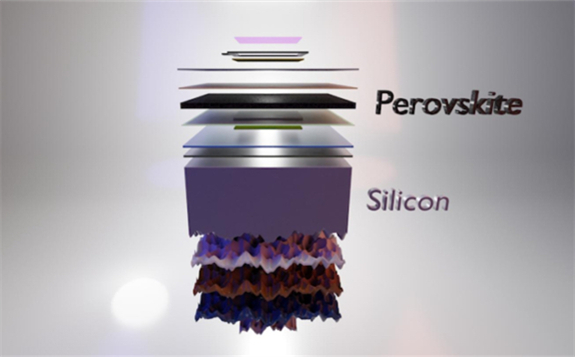Solar cells made from a combination of silicon and a complex perovskite have reached a new milestone for efficiency. The new tandem devices, made by Steve Albrecht and colleagues at the Helmholtz-Zentrum Berlin, Germany, have a photovoltaic conversion efficiency (PCE) of 29.15%, beating out the previous best reported value of 26.2%. They also retain 95% of their initial efficiency even after 300 hours of operation and have an open-circuit voltage as high as 1.92 V.

Solar cells containing two photoactive semiconducting materials with different but complementary electronic band gaps can reach much higher PCEs when used in a tandem configuration than either material on its own. Perovskites, which have the chemical formula ABX3 (where A is typically caesium, methylammonium or formamidinium; B is lead or tin; and X is iodine, bromine or chlorine), are one of the most promising thin-film solar-cell materials around because they are efficient at converting the visible part of the solar spectrum into electrical energy. Since silicon is an efficient absorber of infrared light, combining silicon with a perovskite helps to make the most of the Sun’s output.
“Perfect bed” for perovskite
Working with Vytautas Getautis and his team at the Kaunas Technical University in Lithuania, Albrecht and colleagues constructed their tandem solar cell by sandwiching a self-assembled monolayer (SAM) of a novel carbazole-based molecule between a complex perovskite with a 1.68 eV band gap and an indium tin oxide electrode connected to the silicon. Electrical charge carriers (electrons and holes) can diffuse through perovskites quickly and over long lengths, and adding the SAM layer facilitates the flow of electrons and holes even further. “We first prepared the perfect bed, so to speak, on which the perovskite lays on,” explains Amran Al-Ashouri, a member of Albrecht’s team.
To understand the various processes at play at the interface of the perovskite and the SAM, the researchers studied the interface using a combination of transient photoluminescence spectroscopy, computational modelling, electrical characterization and time-resolved terahertz photoconductivity measurements. The information gleaned from these and other techniques enabled them to optimize the device’s so-called fill factor – a key parameter for photovoltaic devices, and one where perovskite-based solar cells have long fallen short of better-established solar cell materials.
Accelerating hole transport
In Albrecht and colleagues’ experiments, the fill factor depends on how many charge carriers are “lost” on their way out of the SAM-perovskite interface. These losses occur due to a process known as nonradiative recombination, in which excited electrons and holes recombine without emitting light – an unwanted interaction that lowers the efficiency of power conversion.
In the new tandem device, the electrons flow in the direction of incoming sunlight through the SAM, while the holes move in the opposite direction through the SAM into the electrode. The researchers observed, however, that the speed at which holes are extracted is much lower than the corresponding speed for electrons – something that would normally limit the fill factor. According to Al-Ashouri, the new SAM solves this problem by considerably accelerating hole transport, which improves the fill factor and makes the perovskite cell more efficient.
Members of the team, which also includes researchers from the universities of Potsdam in Germany, Ljubljana in Slovenia and Sheffield in the UK as well as the Physikalisch-Technische Bundesanstalt (PTB), HTW Berlin and the Technische Universität Berlin, say that the maximum PCE possible for their design — 32.4% — is now “within reach”. “To this end, we plan to further reduce resistive losses in the tandem solar cell to explore the full PCE potential well above 30%,” team member Eike Köhnen tells Physics World.